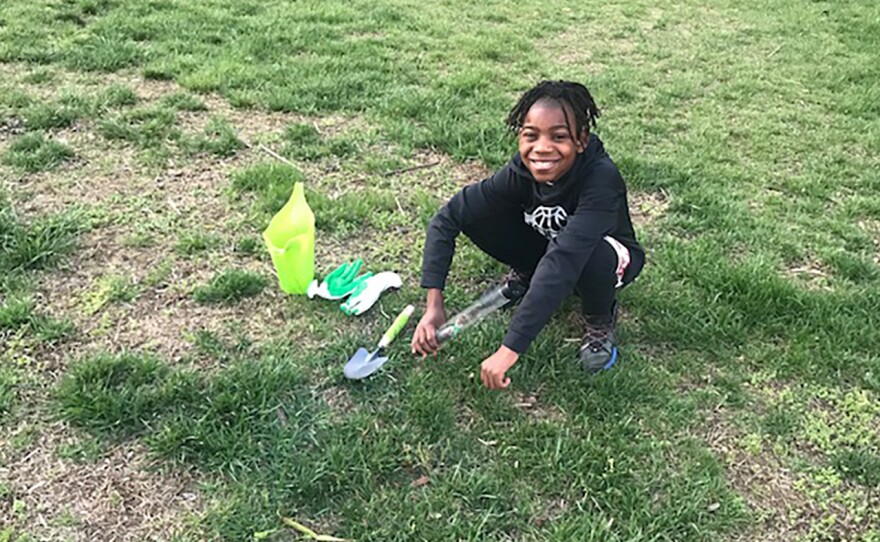Article by Bianca Myrick, Executive Director of the Virginia Association for Environmental Education
“Mooommmmm, look what I see!” How many times have I heard that sound while my 10-year-old has been playing outside? A million times maybe. Listening and watching the neighborhood friends create new variations of games and observe wildlife is refreshing. While outside play may appear to be a routine day outdoors, it can easily turn into an opportunity to raise our next generation of environmentally aware kids.
The Environmental Protection Agency defines environmental education as a process that allows individuals to explore environmental issues, engage in problem solving, and take action to improve the environment. The National Association for Environmental Education provides this definition: the process that helps individuals, communities, and organizations learn about the environment, and develop skills to solve global challenges.
While there may be several similar definitions and perspectives, as a mom and educator, I like to think of it as allowing our children to learn and explore through nature. As they grow, they begin to appreciate and take care of the environment.
Let’s explore and dig into the benefits of raising environmentally engaged children.
Three major benefits of environmental literacy are:
1) Builds Academic & Social Skills
Children are so imaginative and expressive when outdoors. Environmental education promotes creativity and artistry. It is a great way to connect them to social, political, economic, and cultural issues which provide a landscape for discussion where youth can formulate their own opinions. An excellent real world problem for them to think about would be urban heat islands.
An urban heat island is a metropolitan area that is significantly warmer than its surrounding areas due to human activities. Cities typically have dark roads, rooftops, and buildings that trap heat from the sun. On average, urban heat islands are five to seven degrees warmer during the day, impacting vulnerable populations such as children, elderly, and communities of color the most. These communities also tend to represent a larger percentage of those that may not have access to air conditioning. Higher temperatures outdoors can cause heat related illnesses, and intensify air pollution.
Sharing with your child how urban heat islands and the lack of shade impact some communities more than others, is a great way to start conversations about inequity and practices such as redlining that have impacted communities of color. Check out Throwing Shade in RVA to see how Dr. Jeremy Hoffman and Groundwork RVA are engaging youth in tackling this issue in Richmond, Virginia.
Being exposed to environmental problems allows students to develop solutions and can engage them in service learning. As they take action, communities are strengthened, and parents are fostering the next generation of environmental advocates that will pass on healthy habits. Debates, essay writing, and allowing your child to organize a park or neighborhood clean up or planting trees are great ways to get them involved socially while developing leadership skills. Additionally, children exposed to environmental literacy perform better in other subjects such as science and math based on several scientific studies.
2) Strengthens Healthy Minds & Bodies
Environmental education also promotes a healthy lifestyle, builds community, and provides physical and mental health benefits. Planting trees and other vegetation lowers the surface and air temperatures, and can reduce the need for air conditioning. This is also a great way to get outside and get physically active. Planting trees, along with something as simple as walking and hiking a trail, engages children while providing much needed family exercise. Introducing children to the outdoors can reduce stress and anxiety levels. Research confirms that just two hours in nature per week is associated with good health.
This is why organizations like Capital Trees and Tree Fredericksburg host workdays for community members to teach about sustainable care of landscapes and also to build community. Their goal is to improve the environment, and the well-being of individuals and communities. Sign up with an organization such as this to get your family involved.
3) Creates a Generational Exchange
Environmental literacy has a trickle down effect, or shall we say- a trickle up effect? A 2013 study provides evidence that youth who participated in an environmental literacy program passed their knowledge to their parents through routine sharing of information. As the children developed sustainable habits, they shared these with their parents as well. Aside from the ability to change knowledge, skills, and attitudes toward the environment, fostering environmental literacy within our children shapes them to care for the world around them for years to come. So when your child brings home those little seedlings or trees from their classroom for Arbor Day, take them outside and share with them what a difference they can make. Check out these resources on how you and your child can get started with planting a tree.
Anne Little, Executive Director of Tree Fredericksburg shared one of her favorite sayings which is "We do not inherit the earth from our ancestors, we borrow it from our children.” And she believes we should always return something we borrow in better condition than when we received it.
Ditto Anne.




